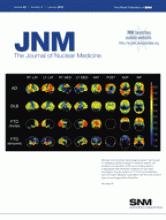Size matters: Boellaard provides perspective on the need for harmonized PET/CT procedures and scanner performance and previews an article in this issue of JNM on the effects of varying standardized uptake value metrics on treatment evaluation.Page 1
SUVpeak for response quantification: Vanderhoek and colleagues explore the impact of different definitions of peak region of interest on quantification of peak standardized uptake value and individual tumor response.Page 4

PVE correction and PET: Hatt and colleagues investigate the results of partial-volume effect correction on the predictive and prognostic value of metabolically active tumor volume measurements on 18F-FDG PET baseline scans in esophageal cancer patients.Page 12
EBV DNA and PET parameters: Chang and colleagues examine the association of 18F-FDG PET functional parameters and Epstein-Barr virus DNA load with clinicopathologic characteristics and clinical outcomes in patients with nasopharyngeal carcinoma.Page 21
PET and glioma survival: Schwarzenberg and colleagues compare the value of 18F-FLT PET and MRI for early outcome predictions in patients with recurrent malignant glioma on bevacizumab therapy.Page 29

PET and astrocytosis: Carter and colleagues describe a multitracer PET investigation, including 11C-DED to measure monoamine oxidase B in astrocytes, conducted in healthy volunteers and individuals with varying degrees of dementia.Page 37

Resynchronization and myocardial scar: Xu and colleagues determine the effect of scar location, scar burden, and left ventricular lead position on cardiac resynchronization therapy outcomes.Page 47
“Staging” atherosclerosis: Ogawa and colleagues describe the effect of foam cell formation on 18F-FDG uptake on PET using cultured mouse peritoneal macrophages to identify the stage at which atherosclerotic lesions can be detected.Page 55
PET and dementia: Bohnen and colleagues provide an educational review of scientific literature since 2000, with evidence for the value of 18F-FDG PET in dementia growing through autopsy and clinical studies, cohort investigations, and multicenter analyses.Page 59
Small-scale dosimetry of testes: Larsson and colleagues present a small-scale dosimetry model for calculation of S factors for several different source–target configurations within human testicular tissue.Page 72

177Lu-cG250 RIT: Stillebroer and colleagues estimate radiation-absorbed doses to normal tissues and tumor lesions during radioimmunotherapy with 177Lu-cG250 in patients with metastasized renal cell carcinoma and assess resulting data for accuracy and correlation with toxicity.Page 82
IGF-1–targeting Affibody molecule: Tolmachev and colleagues evaluate the feasibility of in vivo radionuclide imaging of insulinlike growth factor type-1 receptor expression in prostate cancer xenografts using a small nonimmunoglobulin-derived binding protein.Page 90

Beyond the Warburg effect: Qu and colleagues report a method to prepare l-[5-11C]-glutamine, a probe with potential use in assessing metabolism in glutaminolytic tumors, and evaluate the tracer through in vitro and in vivo studies.Page 98
Genotoxicity of cobalt ferrite: Hwang and colleagues explore changes in gene expression profiles influenced by silica-coated cobalt ferrite magnetic-fluorescence nanoparticles and silica-free cobalt ferrite magnetic-core nanoparticles in vivo and in vitro.Page 106
Targeted immuno-imaging of metastasis: Nayak and colleagues contrast the utilities of MRI and PET using 89Zr-panitumumab to assess the status of human epidermal growth factor receptor 1 in different models of distant metastasis.Page 113

18F-AZAN PET: Kuwabara and colleagues perform preclinical studies on a new radiolabeled antagonist of the main cerebral subtype of nicotinic acetylcholine receptors and discuss the potential for clinical PET in drug investigations.Page 121

Automated LBM evaluation from PET/CT: Chan describes the development of a computerized method that assesses whole-body lean body mass based on CT data from the limited whole-body coverage typically acquired in PET/CT studies.Page 130
Quantitative PET and human uPAR: Persson and colleagues investigate whether PET can be used to quantify expression levels of urokinase-type plasminogen activator receptor, a biomarker of poor prognosis in a number of human cancers.Page 138

HER2 imaging with 18F-NOTA-ZHER2:2395: Heskamp and colleagues determine whether an 18F-labeled Affibody molecule is a suitable agent for imaging of HER2 expression and describe potential applications in patient selection for targeted therapies.Page 146

123I-Ioflupane SPECT: Djang and colleagues introduce an SNM practice guideline on dopamine transporter imaging with an agent that can detect degeneration of dopaminergic nigrostriatal pathways, allowing differentiation of some causes of parkinsonism and of essential tremor from presynaptic parkinsonian syndromes.Page 154
ON THE COVER

Although most functional neuroimaging research has focused on identifying cerebral changes of Alzheimer disease, the sensitivity and specificity of PET as an imaging adjunct in diagnosing other dementia conditions has also been investigated. Specific patterns of 18F-FDG hypometabolism have now been validated in association with the most common types of neurodegenerative dementias.See page 65.
- © 2012 by the Society of Nuclear Medicine, Inc.







